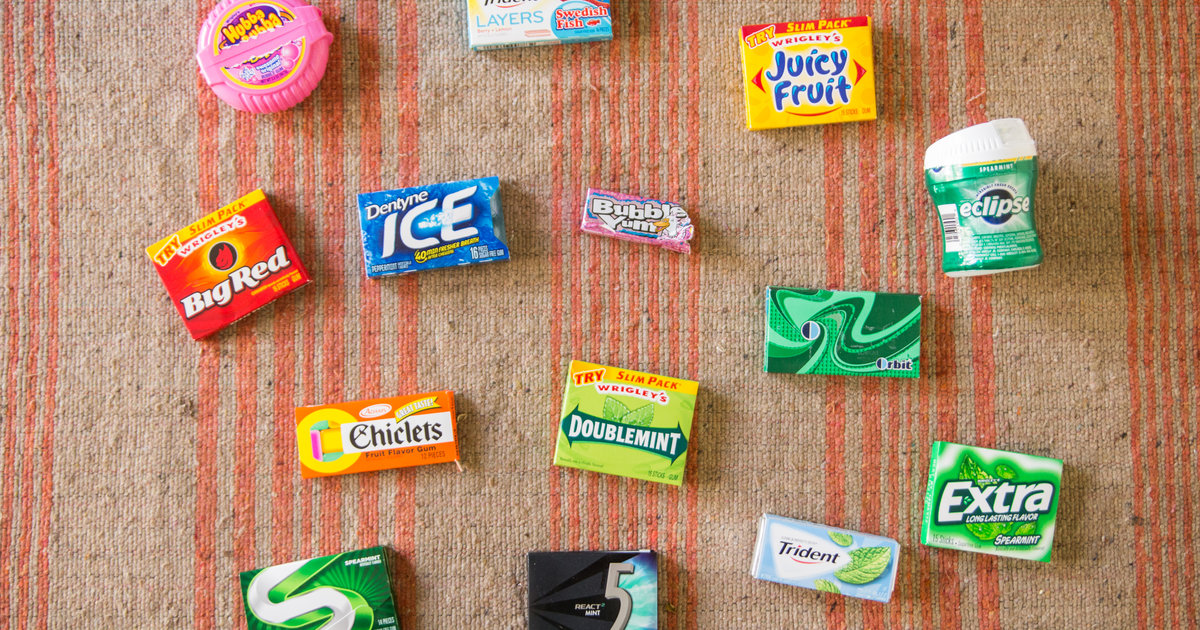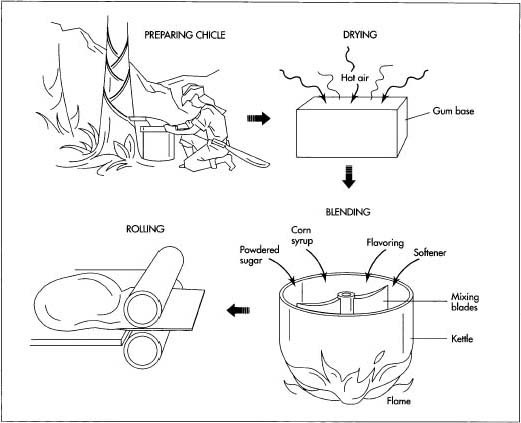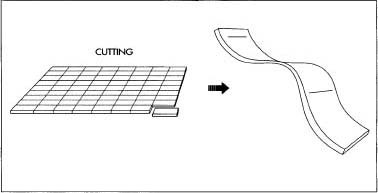
Image credit: thrillist
Chewing gum is one of my favorite sweets during my childhood. Despite a large number of artificial ingredients; I enjoyed chewing it. After all, I was a kid. I didn’t know the difference between ingredients and thought about how intense the flavors are. What makes the flavors so intense? how are they manufactured? what are the food laws behind manufacturing them? what are the risk/ benefits of chewing gums? these are some of the questions I will discuss today.
What is chewing gum?
I’d like to include a little history behind this interesting product before we discuss anything else. Science meets food gives a brief history of chewing gum, “The first commercial gum was created by John B. Curtis in 1848 and called State of Maine Spruce gum. Fun fact: the first commercialized gum was pink! Why? Coincidence — pink happened to be the only color Curtis had at the time. However, the first patented chewing gum did not come along until a little over 20 years later in 1869. Ironically, it was developed by dentist William Semple of Mount Vernon, OH. William Wrigley Jr. was the first to actually advertise commercial chewing gum in 1920’s, which helped make Wrigley’s spearmint and Juicy Fruit the mega-popular brands they are today.” Also, madehow.com continues, “Throughout history, people in many regions have selected naturally chewy and aromatic substances as breath fresheners or thirst quenchers. The Greeks used mastic tree resin; the Italians, frankincense; the West Indians, aromatic twigs; the Arabs, beeswax.”
sugar-free chewing gum formulation:
pie chart of the general composition of sugar-free gum, it usually contains 4 ingredients: flavorings, softeners, gum base, and sweeteners.
Healthline breaks down the ingredients function as follow:
“Recipes can vary between brands, but all chewing gums have the following basic ingredients:
- Gum: The non-digestible, rubbery base used to give gum its chewy quality.
- Resin: Usually added to strengthen gum and hold it together.
- Fillers: Fillers, such as calcium carbonate or talc, are used to give gum texture.
- Preservatives: These are added to extend shelf life. The most popular choice is an organic compound called butylated hydroxytoluene (BHT).
- Softeners: These are used to retain moisture and prevent the gum from hardening. They can include waxes like paraffin or vegetable oils.
- Sweeteners: Popular ones include cane sugar, beet sugar and corn syrup. Sugar-free gums use sugar alcohols like xylitol or artificial sweeteners like aspartame.
- Flavorings: Added to give a desired flavor. They can be natural or synthetic.”
According to Made How, “Chewing gum is a sweetened, flavored confection composed primarily of latex, both natural and artificial. Organic latex, a milky white fluid produced by a variety of seed plants, is best known as the principal component of rubber. The manufacture of chewing gum in the United States has come a long way from loggers chopping off wads of spruce gum for chewing pleasure, yet the base of the gum remains the sap of various rubber trees, or, in most cases, a synthetic substitute for such sap. Natural gum bases include latexes like chicle, jelutong, gutta-percha, and pine rosin. Increasingly, natural resins other than chicle have been used because chicle is in extremely short supply: a chicle tree yields only 35 ounces (one kilogram) of chicle every three to four years, and no chicle plantations were ever established. However, natural latex in general is being replaced by synthetic substitutes. Most modern chewing gum bases use either no natural rubber at all, or a minimal amount ranging from ten to twenty percent, with synthetic rubbers such as butadiene-styrene rubber, polyethylene, and polyvinyl acetate making up the rest.”
How is chewing gum manufactured?

The diagram above from madehow.com gives a simple explanation of the chewing gum manufacturing: “Chewing gum base consists either of natural latex or a synthetic substitute. Natural latex such as chicle is harvested by making large X-marks on rubber trees and then collecting the substance as it runs down the tree. After grinding the base to form a coarse meal, the mixture is dryed for a day or two. Next, the mixture is heated in large kettles while the other ingredients are added. Large machines then pummel, or “knead,” the mass until it is properly smooth and rubbery, and it is put on a rolling slab and reduced to the proper thickness.”

Madehow.com continues by mentioning the following: “After being dusted with powdered sugar, the gum is scored into a pattern of rectangles, seasoned, and broken into sticks. The gum is now ready to be packaged and shipped to retail outlets.”
Quality control of chewing gum
Transparency can be an issue as madehow.com mentions, “Federal regulations allow a typical list of ingredients on a pack of chewing gum to read like this: gum base, sugar, corn syrup, natural and/or artificial flavor, softeners, and BHT (added to preserve freshness). This vagueness is mainly due to the chewing gum manufacturers’ insistence that all materials used are part of a trade secret formula.” This is a challenge for the chewing gum industries but will hopefully be solved with the help of research and development. Also, to add, most of the ingredients listed in chewing gum is safe to consume and is food grade and fit for human consumption.
Despite this, madehow.com mentions several quality control checks and high cleanliness standards are implemented. Raw ingredients are checked and go through several checks for rocks, impurities, texture, cleanliness, dirt before shipment. This is done at every step in the manufacturing process. Also, the process is untouched by human hands at every stage to keep the process clean. Only the highest quality chewing gum passes with a very strict purity test before it’s sold to the general public. The research and development team is responsible for testing at every step of the manufacturing process.
The good, bad, and ugly of chewing gum
The bad & ugly
1.Tooth decay: research and development are working on resolving this issue as madehow.com mention,
” Another recent innovation is a chewing gum imbued with a patented compound that helps to repair tooth enamel. The compound, amorphous calcium phosphate, crystallizes when chewed, triggering the natural remineralization process by which the body rebuilds damaged teeth. Under ideal circumstances, the body generates enough amorphous calcium phosphate to repair teeth organically, but many people eat more sugar than their bodies can fight. This experimental gum would help to protect these people against tooth decay. Researchers hope to have the enhanced gum in stores by 1996.”
2. The laxative effect of sugar-free gum: sugar-free gum cause digestive distress and diarrhea and people with IBS can have issues as well.
3. Jaw issues: according to Healthline, “it’s been suggested that constant chewing could lead to a jaw problem called temporomandibular disorder (TMD), which causes pain when you chew.”
4. Headaches: Healthline continues by saying, “One recent review found a link between regularly chewing gum, migraines and tension headaches in people prone to these conditions. More research is needed to find out if chewing gum actually causes these headaches.”
Despite these “bad & ugly” lists; the level of the ingredients is too low for any human harm. Nevertheless, some chewing gum manufacturers contain controversial ingredients.
The good
Despite the bad and ugly, GILBERT A. LEVEILLE, gives general benefits of chewing gum based on a survey asking consumers why they chew gum. The article continues by explaining the following, “Not surprisingly, consumer trend data (Wrigley, 2003, 2005) indicate that the main reasons people chew gum are “to freshen breath,” “to enjoy the taste,” and for a “healthy mouth.” Yet, an increasing number of consumers view chewing gum as a means to help increase focus or concentration, reduce tension or stress, or manage caloric intake (Figure 1). Research has shown that chewing gum has a number of benefits in oral health, including removing food debris, neutralizing plaque acids, aiding in the remineralization of tooth enamel, and even helping reduce tooth decay. Several clinical trials demonstrate the benefits of chewing sugar-free gum on cavity reduction. For example, a long-term, two-year randomized, blind clinical trial was conducted in Budapest, Hungary, with 547 children aged 8–13 years old at the start. The researchers concluded that the gum chewing resulted in a 39% decline in dental caries incidence compared to the non-chewing controls (Szoke et al., 2001).” Also, there is research shows an increase in blood flow to the brain which helps increase focus.
Choosing the right chewing gum
Choosing a sugar-free chewing gum with xylitol would be a good option as it decreases tooth decay by 75% as mentioned by Healthline. Other options: sweeteners like low-calorie Stevia can be a good alternative as well. Certain people who have IBS can’t chew gum because of digestive issues and it’s not recommended.
Chewing gum is an interesting, complex product which has challenges for both manufacturers and consumers. However, it will be interesting to see what changes will happen in the future as the food supply is changing with an increase in the world population by 2050.
References
1.Website: https://www.sciencefocus.com/science/what-is-chewing-gum-made-of/
2. Website: http://www.madehow.com/Volume-1/Chewing-Gum.html
4. A critical gel fluid with high extensibility: The rheology of chewing gum. Journal of Rheology 58, 821; Website: https://www.researchgate.net/publication/262182753_A_critical_gel_fluid_with_high_extensibility_The_rheology_of_chewing_gum
5. Website: http://www.gumassociation.org/index.cfm/facts-figures/the-story-of-gum/
6. ALEX PIERCE (2017). Chew on This! Science Meets Food. Institute of Food Technologist Student Association (IFTSA). Website: http://sciencemeetsfood.org/chew-on-this/
7. Understanding the Science Behind Chewing Gum.GILBERT A. LEVEILLE. September 2007, Volume 61, No.9, Institute of Food Technologist. Website: http://www.ift.org/Food-Technology/Past-Issues/2007/September/Features/Understanding-the-Science-Behind-Chew-ing-Gum.aspx
8. Madeline Puckette (March 14th, 2016). The Real Difference Between Flavor vs Taste. Wine Folly, llc.; Website: https://winefolly.com/tutorial/taste-vs-flavor-vs-aroma/
9. Helen West, RD (UK) (October 27, 2016). Chewing Gum: Good or Bad? Healthline; Website: https://www.healthline.com/nutrition/chewing-gum-good-or-bad

Wow- I’ve always wondered about gum. Have you visited that gum wall in seattle?
On Sun, Apr 14, 2019, 4:23 AM Living Well In The 21st Century wrote:
> Muayyad Karadsheh posted: ” Chewing gum is one of my favorite sweets > during my childhood. Despite a large number of artificial ingredients; I > enjoyed chewing it. After all, I was a kid. I didn’t know the difference > between ingredients and thought about how intense the flavors are.” >
LikeLiked by 1 person
Yeah I have lol you should do an episode on chewing gum/bubble gum. Challenge for you. Can you find a sustainable company?
LikeLike